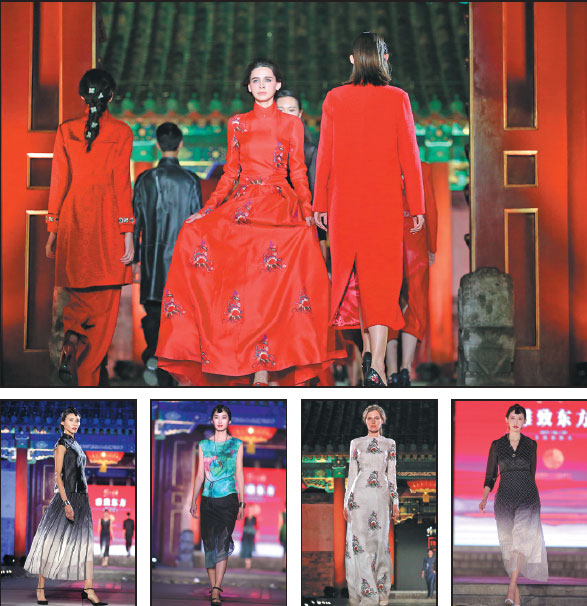Heritage gets a boost
By Sun Yuanqing (China Daily) Updated: 2017-06-16 07:08An exhibition on Suzhou embroidery, which is known for its subtlety, brings to the fore its long history. Sun Yuanqing reports.
Recent fashion events in Beijing have given new meaning to intangible cultural heritage. The shows celebrating Chinese garments were held at Prince Gong's Mansion recently.
The events, supported by the department of intangible cultural heritage under the Ministry of Culture, were organized by the China National Garment Association, the Beijing Institute of Fashion Technology, the organizing committee of China Fashion Week and Minzu University of China.
The shows, held over June 5-10, included an exhibition on Suzhou embroidery, which dates back to more than 2,000 years and is known for its subtlety.
The exhibition showcased garments, paintings, and demonstrated the skills of the makers.
Three academic forums were held during the period - on Suzhou embroidery, traditional attire and traditional weaving and printing, respectively.
Six fashion shows were also held as fashion brands demonstrated how they were enlivening Chinese garment culture.
The collections showcased traditional handcrafts - Su embroidery, Jing embroidery, Cantonese embroidery and Chinese silk tapestry - to demonstrate how traditional craftsmanship can not only survive but thrive.
At the fashion shows, NE Tiger showed qipao - gowns and wedding dresses featuring Su embroidery. It also showcased replicas of costumes from the Qing Dynasty (1644-1911).
Liang Zi's collection featured Chinese silk treated with a special plant juice, while Zhao Yufeng's collection featured clothes for a family, from a grandfather to young children.
Meanwhile, the Eve Group used ethnic Miao embroidery in its clothing for men and women.
In the clothes, traditional Miao embroidery was updated to cater to modern tastes.
Eve, which has been in the business for 23 years, has a team that specializes in discovering and documenting traditional Chinese craftsmanship.
It has a huge database of Chinese craftsmen and women and their works, and has been used extensively in its collections, exhibitions and runway shows in Milan, London and Paris in recent years.
Eve has also set up an alliance of local brands so that its members can benefit from the database.
The brand has also helped build a museum in Guizhou province that exhibits works by the embroiderers.
"These people (the embroiderers) are preserving heritage with their hands. I want to share their craftsmanship with the world, to let it see the beauty of our country," says Xia Hua, founder and chairwoman of the Eve Group.
Sun Xuguang, director of the Beijing Prince Gong Palace Museum says: "We hope that the events will promote ties between artisans and the textile industry."
"We want to reinterpret traditional craftsmanship with creativity and nurture brands. We also want to pay tribute to the artisans by protecting and rejuvenating our cultural heritage," he says.
The museum is an avid promoter of Chinese culture, and will hold shows every June to celebrate the country's intangible cultural heritage.
After the fashion shows, it will launch its Kunqu Opera show season to celebrate Chinese opera art.
Meanwhile, Yang Jian, deputy director of the China National Garment Association, says the textile industry should invest more to bring traditional craftsmanship into the fashion industry in terms of design, branding and manufacturing.
The Beijing Institute of Fashion Technology, the top university of fashion design in the country, has been stressing the value of traditional craftsmanship in its curriculum, says Jia Ronglin, deputy dean of the institute.
Contact the writer at sunyuanqing@chinadaily.com.cn
|
Models show creations of fashion brands that demonstrate how they enliven Chinese garments at a recent runway show at Prince Gong's Mansion in Beijing. Photos By Jiang Dong / China Daily And Provided To China Daily |
- 'Cooperation is complementary'
- Worldwide manhunt nets 50th fugitive
- China-Japan meet seeks cooperation
- Agency ensuring natural gas supply
- Global manhunt sees China catch its 50th fugitive
- Call for 'Red Boat Spirit' a noble goal, official says
- China 'open to world' of foreign talent
- Free trade studies agreed on as Li meets with Canadian PM Trudeau
- Emojis on austerity rules from top anti-graft authority go viral
- Xi: All aboard internet express












